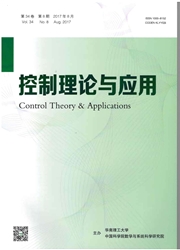

 中文摘要:
中文摘要:
Terminal iterative learning control(TILC) is developed to reduce the error between system output and a fixed desired point at the terminal end of operation interval over iterations under strictly identical initial conditions. In this work, the initial states are not required to be identical further but can be varying from iteration to iteration. In addition, the desired terminal point is not fixed any more but is allowed to change run-to-run. Consequently, a new adaptive TILC is proposed with a neural network initial state learning mechanism to achieve the learning objective over iterations. The neural network is used to approximate the effect of iteration-varying initial states on the terminal output and the neural network weights are identified iteratively along the iteration axis.A dead-zone scheme is developed such that both learning and adaptation are performed only if the terminal tracking error is outside a designated error bound. It is shown that the proposed approach is able to track run-varying terminal desired points fast with a specified tracking accuracy beyond the initial state variance.
 英文摘要:
英文摘要:
Terminal iterative learning control(TILC) is developed to reduce the error between system output and a fixed desired point at the terminal end of operation interval over iterations under strictly identical initial conditions. In this work, the initial states are not required to be identical further but can be varying from iteration to iteration. In addition, the desired terminal point is not fixed any more but is allowed to change run-to-run. Consequently, a new adaptive TILC is proposed with a neural network initial state learning mechanism to achieve the learning objective over iterations. The neural network is used to approximate the effect of iteration-varying initial states on the terminal output and the neural network weights are identified iteratively along the iteration axis.A dead-zone scheme is developed such that both learning and adaptation are performed only if the terminal tracking error is outside a designated error bound. It is shown that the proposed approach is able to track run-varying terminal desired points fast with a specified tracking accuracy beyond the initial state variance.
 同期刊论文项目
同期刊论文项目
 同项目期刊论文
同项目期刊论文
 A Novel Higher-order Model-free Adaptive Control for a Class of Discrete-time SISO Nonlinear Systems
A Novel Higher-order Model-free Adaptive Control for a Class of Discrete-time SISO Nonlinear Systems Data-weighting based discrete-time adaptive iterative learning control for nonsector nonlinear syste
Data-weighting based discrete-time adaptive iterative learning control for nonsector nonlinear syste An ILC scheme for a class of nonlinear continuous-time systems with time-iteration-varying parameter
An ILC scheme for a class of nonlinear continuous-time systems with time-iteration-varying parameter Data-driven model-free adaptive iterative learning control for a class of discrete-time nonlinear sy
Data-driven model-free adaptive iterative learning control for a class of discrete-time nonlinear sy H-infinity Filtering for Markovian Switching Genetic Regulatory Networks with Time-Delays and Stocha
H-infinity Filtering for Markovian Switching Genetic Regulatory Networks with Time-Delays and Stocha Discrete-time adaptive ILC for non-parametric uncertain nonlinear systems with iteration-varying tra
Discrete-time adaptive ILC for non-parametric uncertain nonlinear systems with iteration-varying tra A data-driven iterative feedback tuning approach of ALINEA for freeway traffic ramp metering with PA
A data-driven iterative feedback tuning approach of ALINEA for freeway traffic ramp metering with PA Coordinated iterative learning control schemes for train trajectory tracking with overspeed protecti
Coordinated iterative learning control schemes for train trajectory tracking with overspeed protecti On the Intrinsic Concordance between the Wide Scattering Feature of Synchronized Flow and the Empiri
On the Intrinsic Concordance between the Wide Scattering Feature of Synchronized Flow and the Empiri 期刊信息
期刊信息
